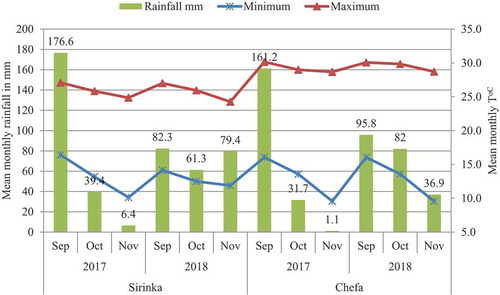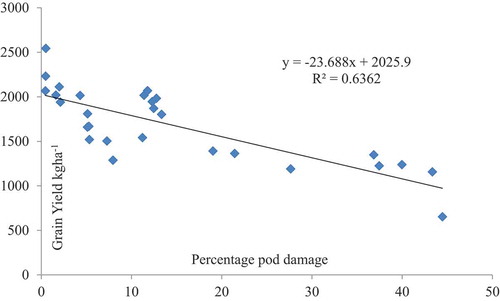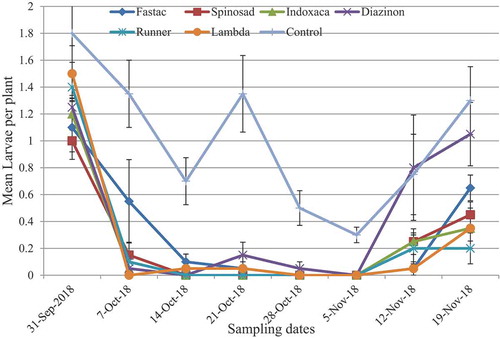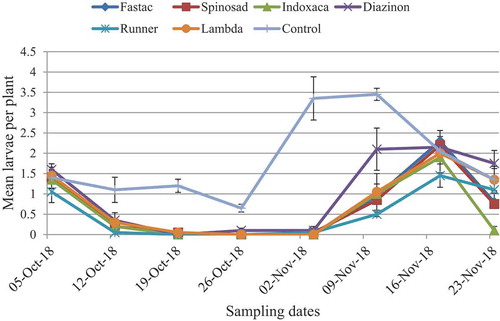 ?Mathematical formulae have been encoded as MathML and are displayed in this HTML version using MathJax in order to improve their display. Uncheck the box to turn MathJax off. This feature requires Javascript. Click on a formula to zoom.
?Mathematical formulae have been encoded as MathML and are displayed in this HTML version using MathJax in order to improve their display. Uncheck the box to turn MathJax off. This feature requires Javascript. Click on a formula to zoom.Abstract
Helicoverpa armigera is a major pest of chickpea in Ethiopia. Field experiment was conducted to evaluate the efficacy of insecticides viz., Fastac, Spinosad, Indoxacarb, Diazinon, Runner, and Lambda cyhalothrin were tested at Sirinka on trial site and Chefa on farmers’ field in a randomized complete block design (RCBD) with four replications during 2017 and 2018. Percentage pod damage, mean larval count per plant, hundred seed weight, and grain yield were significantly affected by the treatments; all tested insecticides significantly reduced the percentage pod damage and mean larvae per plant accordingly increased grain yield ha−1 among insecticides Indoxacarb (48.11) and Spinosad (43.37%) gave higher relative yield increment with maximum MRR 8112.24% and 7698.28% respectively. Thus, the application of Indoxacarb (Avaunt 150 SC) 0.3 Lha−1 or Spinosad (Tracer 480 SC) 0.15 Lha−1 three times with a week interval can be advised for the management of H.armigera; however, it needs further investigation for the interval and frequency.
PUBLIC INTEREST STATEMENT
Crop production plays a significant role in developing countries like Ethiopia, both in income and social spheres for improving income and nutrition status. It is well known that human intervention for the sensitive environment is mostly to manage crop pests. Farmers are restricted to the use of synthetic products for the management of crop pests without any technical identification of pests and their stages, specific recommendation, considering the influence on environment sustainability. In this study, the efficacy of newly registered insecticides evaluated for the control of H. armigera on chickpea. Therefore, the results from this study imply the farmers to create effective insect management with minimum environmental risk by using new mode of action low risk, effective and economic insecticide/s.
Competing interest
The authors declared no potential conflict of interest.
1. Introduction
Ethiopia is highly drought-prone and has an agricultural sector that accounts for 85% of employment (Spielman et al., Citation2010). Chickpea can grow on residual moisture which allows farmers to engage in double cropping since chickpea is sown at the end of the rainy season in most of chickpea producing areas of Ethiopia (Gebretsadkan et al., Citation2019). Chickpea and its residues are a source of protein and can reduce malnutrition (Malunga et al., Citation2014). Despite the significant economic and ecological importance, the productivity of chickpea in Ethiopia is far below its potential (Tebkew and Mekasha, Citation2016). In Ethiopia, its average productivity was 2.05 ton ha−1 in 2017/18 (CSA, Citation2018). However, in highly suitable land could generate up to five tons per ha−1 (ICARDA, Citation2019). It contributes 15.18% of Ethiopia’s total pulse production and is second after fababeans (CSA, Citation2018).
The production and productivity of chickpea have been experienced drastically because of biotic and abiotic stresses. It is vulnerable to a broad range of pathogens and the mainly severe pest being gram pod borer H. armigera (Tebkew & Makasha, Citation2016; Wubneh, Citation2016). Pod borer (H. armigera) is the most important pest of chickpea worldwide. It is a highly polyphagous pest and can feed on various plant parts, such as leaves, tender shoots, flower buds, and immature seeds (Gaur et al., Citation2012). Is extremely well adapted to different agro-ecosystems (Gabuin, Citation2015). In tropical areas, breeding is continuous and can exhibit up to 11 generations a year (Baker et al., Citation2014). The pest exhibits overlapping generations in the field (Gabuin, Citation2015). Based on assessment reports, the pest was recorded in all the surveyed localities in Ethiopia (DZARC, 1994, 1996, 1997) as cited on (Kemal et al., Citation2008). Also, recently it was reported prevalent throughout the central and northwestern Ethiopia with different larval density (Tebkew & Ojiewo, Citation2017). Tebekew (Citation2004) reported causing 0.7–32.7% pod damage on the farmers’ field based on the three successive production years survey.
Synthetic insecticides including organophosphates, synthetic pyrethroids, and biorational compounds are the main method for H. armigera control in different parts of the world (Fathipour & Sedaratian, Citation2013). Based on the recent survey report; H. armigera control with insecticide on chickpea is not common in Ethiopia; rather the majority of the farmers follow a “do nothing” strategy (Tebkew & Ojiewo, Citation2017). On the other hand, Ethiopian agriculture is fast transforming from subsistence to commercial farming system and the use of pesticides is expected to increase rapidly as scales of production increase. Even if, the indiscriminate use of pesticides to tackle losses caused by H. armigera can increase the cost of production, affect human health, biodiversity, and the environment (Tebkew & Ojiewo, Citation2017).
Though major producers do not practice insecticide application; fields sprayed with insecticide were still infested (Tebkew & Ojiewo, Citation2017). Also, a high infestation of H. armigera on Chickpea and other legume crops with a less effective effort by producers to protect their crops by spraying different insecticides purchased from local pesticide dealers and farmers’ union has been reported in Bale zone (Kora et al., Citation2018). This phenomenon is common in eastern Amhara producing areas (personal observations); from different contributing factors lack effective insecticide is the most probable reason; though for the wise use of insecticide/s for the maximum protection of products and avoid their drastic side effects on the environment, human health, and natural biocontrol agents. Explore new with a novel mode of action, which is effective at lower dose insecticides currently available on the market to control this pest is required. Hence, this experiment was conducted with main objective of evaluating insecticides efficacy against H. armigera on Chickpea.
2. Materials and methods
2.1. Experimental site description
The field experiment on the management of Helicoverpa armigera was conducted at Sirinka Research Sites of Sirinka Agricultural Research Center and Chefa on farmer’s field during the main cropping seasons (last week of August–first week of December) in 2017 and 2018. The sites, where the field experiment was conducted, are found Lat 11° 45ʹ 10”; 10 o 50ʹ 39” and Lon 39 o 36ʹ 44”; 39° 48ʹ 46” on about 1850 and 1450 m.a.s.l respectively in North wollo and South wollo zones of the Amhara National Regional State, Ethiopia. Based on Ethiopian Minstry of Agriculture, Natural Resources Management & Regulatory Department [MoA] (Citation1998) the areas lied in mid and low-altitude ranges, respectively. The soils of the experimental sites are Eutric Vertisol (Sirinka agricultural research center) which is generally good for chickpea (Cicer arietinum) cultivation. However, it is known to produce in diverse soil types in Ethiopia. The trial sites receive 13.6°C, 27.3°C, and 876 mm; 11.6°C, 30.4°C, and 850 mm annual minimum temperature, maximum temperature and rainfall for Sirinka and Chefa, respectively.
2.2. Experimental design and procedure
A field experiment was conducted using Randomized Complete Block Design (RCBD) replicated four times using six selected insecticides and untreated control. The crop was sown on 40 × 10 cm spacing between row and plants respectively in a gross plot size of 9.6 m2 (2.4 × 4 m) or harvestable plot area of 6.4 m2 with a buffer zone of 1 m between plots and 1.5 m between blocks. The variety Akuri (Kabuli type) recommended to the area was planted without any fertilizer application in the last week of August. All other pertinent field trial management practices (like weeding) were implemented as per the recommendation.
Each plot was received three sprays of each insecticide treatment to get the maximum protection potential of insecticides (Hossain et al., Citation2010). The control plots were sprayed with water only. The application was done with the help of “Solo Knapsack hand sprayer” with 1-liter capacity bottles. Periodic inspection of the chickpea field was made to notice the phenology of the crop and target insect population. The first application was made when the larval population crossed the economic threshold level (one larva per meter row) at the pod setting stage of the crop (Singh et al., Citation2018). However, it is condition dependent and not established in our condition. The second and third sprays were applied at a week interval to get maximum protection of the pest. Further details of each treatment are summarized in Table.
Table 1. Detail of treatments (insecticides)
2.3. Collection of data
Data were collected on the number of larvae of H. armigera a day before the first spray (first week of October) and a week after each spray for three consecutive weeks at both locations in 2017 and for 8 weeks in 2018. Larvae were counted from the whole above-ground parts of 10 randomly selected plants in each plot a week after each spray; besides, after third spray larvae count data were taken up to fifth extra weeks in 2018 at both locations without treatment application. Thus, mean larvae count per plant presented by the extrapolation of three and five consecutive weeks for 2017 and 2018, respectively.
The pod damage was noted during the harvesting of matured crop. Healthy and damaged pods were counted on randomly selected five plants per plot and then percent pod damage was evaluated. Hundred seed weight was taken on randomly selected five plants per plot after threshing by randomly counting 100 undamaged seeds and weighting it. Grain yield was collected from whole harvestable plot area (excluding border rows) then extrapolated for 1 ha. The damage on pods and loss in grain yield caused by the pest was calculated by using formulas adopted from (Savary & Willocquet, Citation2014).
The percentage of pod damage was estimated
Percentage yield loss and relative yield increment were calculated with the following formulas
Where RPYL – relative percentage yield loss; YP – yield of protected plot; YT – yield of control treatment
Where PYI stands for percentage yield increment
2.4. Data analysis
Before analysis, data for the percentage of pods with larval holes were transformed to the arc-sine scale. The experimental data were subjected to two-way ANOVA using Genstat v 18. Mean comparisons for treatment parameters were done using the least significant difference at a 5% level of significance. The partial budget analysis was conducted by considering the insecticides and their application costs as a variable cost with the CIMMYT’s guideline (CIMMYT, Citation1988).
3. Results
The result showed that there was a significant difference among treatments (p < 0.05) for mean larval count per plant, percentage pod damage (except at Sirinka for 2017), a hundred seed weight (in 2017 at both trial sites), and grain yield (Tables and ).
Table 2. The response of insecticides on mean larvae count per plant percentage pod damage hundred seed weight, and grain yield at Sirinka 2017 and 2018
Table 3. The response of insecticides on mean larvae count percentage pod damage, hundred seed weight, and grain yield at Chefa 2017 and 2018
3.1. Effects of insecticides on H. armigera mean larvae count per plant
Mean larvae count per plant was significantly different among treatments at both trial sites for the 2017 and 2018 seasons (p ≤ 0.00). Insecticide-treated plots recorded significantly lower mean larva per plant (Tables and ). At Sirinka Spinosad treated plots recorded lower mean larva count consistently for both years with 0.12 and 0.23 in 2017 and 2018, respectively. However, it is statically non-significant with other insecticides. While untreated control maintained significantly higher larva per plant 0.8 and 1.14 in 2017 and 2018, respectively. Similarly, at Chefa insecticide-treated plots significantly reduced larvae per plant as compared to the control. Both Indoxacarb and Spinisad treated plots recorded the smallest (0.17) mean larva count per plant in 2017; whereas in 2018 Runner (0.23) followed by Indoxacarb (0.31) while on untreated control plots 0.72 and 1.54 mean larva per plant was maintained in 2017 and 2018 respectively at Chefa.
3.2. Effect of insecticides on percentage pod damage
At Sirinka percentage pod damage was significantly lower on insecticide-treated plots ranged from 11.21 (Diazinon) −13.33 (runner) as compared to the untreated control (21.43%) (p ≤ 0.05) in 2018; while in 2017 overall percentage pod damage was lower; it ranges 4.3 (Indoxacarb) to 7.94% (untreated control) it does not reach to statically significant (Table). It is probably due to the overall lower level of infestation during 2017. At Chefa, the insecticides significantly reduced the percentage pod damage for both production years 2017 (p ≤ 0.001) and 2018 (p ≤ 0.05); the minimum percentage pod damage was recorded at Runner (0.45%) followed by Indoxacarb (0.48) and Spinosad (0.50) treated plots at Chefa in 2017 while the maximum %pod damage was recorded on untreated control plot at Chefa 2018 (44.46%) (Table ).
3.3. Effect of insecticides on hundred seed weight
In 2017 there was a significant difference in hundred seed weight (p < 0.05) at both sites (Tables and ). A maximum hundred seed weight was recorded on the untreated control treatment (34.95, 34.47 g) at Sirinka and Chefa respectively (Tables and ). Conversely, no significant difference was observed in a hundred seed weight in 2018 at both trial sites.
3.4. Effect of insecticides on grain yield
At Sirinka, insecticide-treated plots recorded significantly higher grain yield ha−1 except for Diazinon; with a higher grain yield on Indoxacarb (2015.59 and 2068.94 kg ha−1) treatment whereas untreated control, treatment was recorded significantly lower grain yield ha−1 with 1288.27 and 1364.38 kg ha−1 in 2017 and 2018, respectively. Similarly, at Chefa untreated control treatment gave lower yield with 1870.2 and 653.0 kg ha−1 in 2017 and 2018, respectively. While higher grain yield was recorded on Spinosad (2544.53) followed by Indoxacarb (2232.380 in 2017). In 2018 Runner was recorded higher grain yield ha−1 (1391.47) followed by Indoxacarb (1348.85 kg ha−1).
Besides to the effect of the insecticides at Chefa, overall mean grain yield was lower in 2018 ranged from (653.0–1391.47 kg ha−1) as compared with (1870.2 to 2544.53 kg ha−1) in 2017 which is in line with the percentage pod damage this scenario may be associated with the presence of relatively high rainfall during the grain filling period in 2018 lead to a frequent infestation the crop by of H. armigera.
The grain yield was highly affected by pod borer infestation. The results revealed that the treatments with high pod borer infestation had minimum grain yield (32.48% relative yield loss); whereas the treatments with maximum protection (Indoxacarb) give higher percentage yield increment (48.11%) followed by Spinosad (43.37%) relative to the untreated control (Table ). According to the regression; percentage pod damage could predict the mean yield to the tune of 63.6% (r2 = 0.636) (Figure ).
Table 4. Relative yield loss and percentage yield increments for both locations in 2017 and 2018
The result from the partial budget analysis of the study by using the overall mean yield indicated that the application of insecticides for the management of H. armigera could be profitable. The maximum average grain yield (1916.44 kg ha−1) with a higher marginal rate of return (8112.24) was obtained from Indoxacarb treatment followed by Spinosad (7698.28) and Fastac (1263.78), and the minimum average yield (1293.97 kg ha−1) was obtained from untreated control plot (Table ).
Table 5. Partial budget analysis
4. Discussion
The current research revealed that evaluated insecticides were effective against H.armigera by reducing larval infestation under field conditions during both years. Based on the overall 2-years experiment at two trial sites Indoxacarb and Spinosad treated plots recorded the lowest mean larvae count per plant. A previous study indicated that these insecticides (indoxacarb and spinosad) induced higher mortality of third instar larvae for H. armigera in laboratory bioassay (Silva et al., Citation2020). Similarly, Indoxacarb proved to be the best over chlorpyriphos and methomyl in reducing the number of larvae based on pre-spray data (Ahmed et al., Citation2004).
The distribution of larval population in the plot was statistically uniform before treatment application started; then after three consecutive weekly application of different insecticides, the population on the treated plots declines almost uniformly to nearly nil up to fifth week at Chefa and sixth week at Sirinka in 2018 (Figures and ). Even on the untreated control plots, there was a relative reduction of mean larval count during the second and third sampling weeks at Sirinka. However, the overall mean larvae per plant are significantly higher on control plots at both sites (Tables and ). It may be due to the buffer zone crossing ability of some insecticides repelling character. The most probable scenario for 2018 the insecticides seems to be ineffective based on the mean larva count per plant is the presence of continuous rainfall in October and November which makes the chickpea and other alternative hosts still green favor the pest population development. On the other hand, in 2017 at both sites, there was serious terminal moisture deficiency (Figure ) during the third spray (mid-October) and onwards leading to premature wilting of the crop. It is known wilted and/or dead plants are unattractive to ovipositing H. armigera moths and are nutritionally less suitable to the larvae (Nyambo, Citation1988). Most probably due to this, we noted lower percentage pod damage at both sites during 2017 even on the untreated control plot.
Figure 4. Mean monthly rainfall (mm), minimum and maximum temperature (oc) of Sirinka and Chefa in Sep- Nov 2017 and Sep- Nov 2018 (Source: National meteorology agency of Ethiopia; East amhara service center, Kombolcha)

Pod damage percentage by the larvae of H.armigera was significantly decreased in treated plots compared to control. The overall lower percentage pod damage was recorded in 2017 at both sites ranging from 4.3 to 7.94 and 0.45 to 12.46 at Sirinka and Chefa respectively being the higher percentage pod damage on the untreated control plots at both trial sites. However, it is relatively lower as compared to the successive year recorded 21.43% and 44.46% at Sirinka and Chefa on untreated control plots. This low pod damage might be due to the low rainfall in mid-October and onwards during 2017 at both sites (Figure ), which limits the continuous breeding of insect pest (Baker et al., Citation2014) also may make the absence of attractive stage of its main alternative hosts overlap to provide continuous pest populations (Nyambo, Citation1988).
The outcome of the 2018 season was similar to the 2017 season at Sirinka (Table ), although the percentage of pod damage was greater than the preceding season. However, based on the magnitude of pod damage it is worthy to mention that treatments during 2018 when there is continuous rainfall in October and November during pod setting and onward stages at both locations the insecticide spray frequency and/or interval were not enough to control H. armigera larval population. Though, three times weekly insecticide applications resulted in a greater than three-fold increase in yield (Wightman et al., Citation1995). The lowest pod damage, as well as grain yield loss, was reported in the treatment where lambda cyhalothrin applied three times at 7 days interval from the flowering stage (Hossain et al., Citation2010). But in the current study mean larvae per plant raise after last spray up to eighth after pod initiation following this high percentage pod damage was recorded.
Generally, the result follows a fashion for the earlier on-farm survey report each season recorded greater pod damage from the preceding season (Tebekew, Citation2004). The overall extent of percentage pod damage was higher at Chefa (low altitude area) converse to Sirinka which is a mid-latitude area. Analogous with Tebekew (Citation2004) Reported extents of pod damage on chickpea by H. armigera to vary with altitude. Hundred seed weight was higher on the untreated control plot at both trial sites. It is probably due to the coexistence of low rainfall and a high dose of insecticide in 2017. It needs further investigation since it is not supported by other scholars for insecticides hurting seed weight.
In response to lower larval population and pod damage, maximum yields were recorded from plots treated with Indoxacarb and Spinosad. The current result proved that Indoxacarb and Spinosad are most effective with a lower dose on H. armigera than recently recommended insecticides (Diazinon and karate) in Ethiopia (Kora et al., Citation2018). Also, other evaluated insecticides like Fastac which is supported by the earlier reports were the least insecticide compared to other carbamate and pyrethroid groups of insecticides against larvae of H. armigera (Zahid & Hamed, Citation2003).
A significant negative association and a linear relationship were found between percent pod damage and grain yield increment which indicated that the proportion of damaged pods in chickpea closely reflected the loss of grain yields. Indicates the impact of insecticides application that contributed to the reduction of percentage pod damage lead to grain yield increment. Analogous results were reported earlier (Tebekew, Citation2004).
Additionally, the effectiveness of treatments on the protection of the grain yield of chickpea was also evaluated through partial budget analysis comparing the marginal rate of return of each treatment by considering the overall mean grain yield maximum marginal rate of return was obtained from Indoxacarb and Spinosad treated plots. Thus, the use of Indoxacarb and/or Spinosad economically profitable in line with earlier reports elsewhere (Singh et al., Citation2018; Roopa & Kumar, Citation2014). Besides to their efficacy and economic feasibility, both are relatively low risk to non-target organisms and the environment; Indoxacarb is a broadspectrum insecticide in a new class of chemical compound with a new mode of action and is registered for use against a wide variety of Lepidopteran pest insects. It is a reduced risk pesticide with very low mammalian toxicity and a benign profile for avian and aquatic toxicity (McKinley et al., Citation2002). Also, Spinosad has excellent control over a wide range of crop pests and offers a large margin of safety to man, beneficial insects/mites and, the environment (Carlson et al., Citation2001). Thus, the use of Indoxacarb and/or Spinosad greatly benefits the producers, users with minimum environmental risk, and need further research on its rate and frequency for the best effective and economical use.
5. Conclusion
All the tested insecticides satisfactorily reduced the mean larvae per plant and percentage pod damage with comparable performance accordingly gave a significant yield increment. The overall percentage of pod damage and larvae per plant was significantly lower in treated plots as compared with the untreated control. Among the insecticides, Indoxacarb and Spinosad have shown effective performance and economically feasible. Hence, the application of Indoxacarb (Avaunt 150 SC) 0.3 Lha−1 or Spinosad (Tracer 480 SC) 0.15 Lha−1 three times with a week interval starting from pod setting can be advised for the management of H.armigera where it is a major production problem like Chefa and Sirinka. However, it needs further research about the specific areas of environmental conditions and crop phenology with pest population dynamics for the interval and frequency of application.
Acknowledgements
The authors acknowledge Amhara Agricultural Research Institute/Sirinka Agricultural Research Centre for financing and facilitating the study.
Additional information
Funding
Notes on contributors

Aderajew Mihretie
Aderajew Mihretie is graduated in plant protection from Bahir dar university, Ethiopia. Currently, he is Agricultural Entomology assistant researcher in Sirinka Agricultural Research Center at Amhara Agricultural Research Institute starting from 2014. He conducted different researches on crop insect pests mainly on fruit fly, fall armyworm, bean stem maggot and blister beetle assessment and field experiments.
References
- Ahmed, S., Rasool, M. R., & Rauf, I. (2004). Comparative efficacy of some insecticides against Helicoverpa armigera Hub. and Spodoptera spp. on tobacco. International Journal of Agriculture & Biology, 6(1), 93–95.
- Baker, R., Bragard, C., Candresse, T., Gilioli, G., Grégoire, J., Holb, I., Jeger, M. J., Karadjova, O. E., Magnusson, C., Makowski, D., Manceau, C., & Van der Werf, W. (2014). Scientific opinion on the pest categorisation of Helicoverpa armigera. EFSA Journal, 12(10), 1–12. https://doi.org/http://doi.10.2903/j.efsa.2014.3833
- Carlson, G. R., Dhadialla, T. S., Hunter, R., Jansson, R. K., Jany, C. S., Lidert, Z., & Slawicki, R. A. (2001). The chemical and biological properties of methoxyfenozide, a new insecticidal ecdysteroid agonist. Pest Management Science, 57(2), 2. https://doi.org/10.1002/1526-4998(200102)57:2%3C115::AID-PS245%3E3.0.CO;2-A
- CIMMYT. (1988). From agronomic data to farmer recommendations: An economics training manual (Completely).
- CSA. (2018). The federal democratic republic of Ethiopia report on area and production of major (Vol. I). Central Stastical Agency of Ethiopia.
- Fathipour, Y., & Sedaratian, A. (2013). Integrated management of Helicoverpa armigera in soybean cropping systems. In Soybean - Pest resistance (pp. 232–271). Croatia: INTECH. https://doi.org/10.5772/54522
- Gabuin, N. D. (2015). Evaluation of isolated fungal entomopathogens and seed extracts of Piper guineense against larvae OF Helicoverpa armigera (Lepidoptera: Noctuidae) in the laboratory. University of Ghana.
- Gaur, P. M., Jukanti, A. K., & Varshney, R. K. (2012). Impact of genomic technologies on chickpea breeding strategies. Agronomy, 2(3), 199–221. https://doi.org/10.3390/agronomy2030199
- Gebretsadkan, Z., Nahom, W., & Kiros, W. (2019). Efficacy of insecticides and crop critical stage for the management of chickpea pod borer (Helicoverpa armigera) in central zone of Tigray, Ethiopia. Journal of Plant Breeding and Crop Science, 11(9), 254–259. http://doi.10.5897/JPBCS2019.-0819
- Hossain, M. S., Islam, M. S., Salam, M. A., Hossain, M. A., & Salma, M. U. (2010). Management of chickpea pod borer, Helicoverpa armigera (Hubner) using neem seed extract and lambda-cyhalothrin in high barind tract. Journal of Bio-science, 18, 44–48. https://doi.org/10.3329/jbs.v18i0.8774
- ICARDA. 2019. A chickpea revolution in Ethiopia. The International Center for Agricultural Research in the Dry Areas. Retrieved June 23, 2020, from https://reliefweb.int/report/ethiopia/chickpea-revolution-ethiopia
- Kemal, A., Mekasha, C., Tsedeke, A., Tadele, T., & Mohamed, D. (2008). Two decades of research on insect pests of grain legumes. In T. Abraham (Ed.), Increasing crop production through improved plant protection volume I Presented at the 14th annual conference of the Plant Protection Society of Ethiopia (PPSE) 19–22 December 2006, Addis Ababa, Ethiopia.
- Kora, D., Teshome, E., & Biftu, A. (2018). On-farm demonstration and evaluation of synthetic insecticides for the control of pod borer (Helicoverpa armigera Hubner) on chickpea in Bale zone. American Journal of Plant Biology, 3(3), 29–32. https://doi.org/http://doi.10.11648/j.ajpb.20180303.11
- Malunga, L. N., Dadon, S. B., Zinal, E., Berkovich, Z., Abbo, S., & Reifen, R. (2014). The potential use of chickpeas in the development of infant follow-on formula. Nutrition Journal, 13(8), 1–6. https://doi.org/10.1186/1475-2891-13-8
- McKinley, N., Kijima, S., Cook, G., & Sherrod, D. (2002, January 9–11). Avaunt (Indoxacarb): A new mode of action Insecticide for control of several key orchard pests. Proceedings of 76th Annual Western Orchard Pest & Disease Management Conference, Pullman, Washington: Washington State University.
- Ethiopian Minstry of Agriculture, Natural Resources Management & Regulatory Department (MoA). (1998). Agro-ecological zones of Ethiopia. MoA.
- Nyambo, B. T. (1988). Significance of host-plant phenology in the dynamics and pest incidence of the cotton bollworm, Heliothis armigera Hübner (Lepidoptera: Noctuidae), in Western Tanzania. Crop Protection, 7(3), 161–167. https://doi.org/10.1016/0261-2194(88)90064-6
- Roopa, M., & Kumar, C. T. (2014). Bio-efficacy of new insecticide molecules against capsicum fruit borer, Helicoverpa armigera (Hubner). Global Journal of Biology Agriculture Health Science, 3(3), 219–221.
- Savary, S., & Willocquet, L. (2014). Simulation modeling in botanical epidemiology and crop loss analysis. The Plant Health Instructor, 173. HAL. https://doi.org/http://doi.10.1094/PHI-A-2014-0314-01
- Silva, F. R., Trujillo, D., Bernardi, O., Rodrigues, J. C. V., Bailey, W. D., Gilligan, T. M., & Carrillo, D. (2020). Comparative toxicity of Helicoverpa armigera and Helicoverpa zea (Lepidoptera: Noctuidae) to selected insecticides. Insects, 11(7), 431. https://doi.org/10.3390/insects11070431
- Singh, D. R., Kumar, S., Kishor, K., & Kewal, R. (2018). Bio-efficacy of insecticides against Helicoverpa armigera in chickpea. Legume Research, 43(2), 276–282. https://doi.org/http://doi.10.18805/LR-3960.
- Spielman, D. J., Byerlee, D., Alemu, D., & Kelemework, D. (2010). Policies to promote cereal intensification in Ethiopia: The search for appropriate public and private roles. Food Policy, 35(3), 185–194. https://doi.org/http://doi.10.1016/j.foodpol.2009.12.002
- Tebekew, D. (2004). Importance of pod borer in some chickpea growing regions of Ethiopia. Pest Management Journal of Ethiopia, 8, 105–110.
- Tebkew, D., & Makasha, C. (2016). Status of chickpea insect pests management research in Ethiopia. In L. K. D. Tebkew & F. Asnake (Eds.), Harnessing chickpea value chain for nutrition security and commercialization of smallholder agriculture in Africa (pp. 221–242). EIAR.
- Tebkew, D., & Ojiewo, C. O. (2017, November). Incidence and within field dispersion pattern of pod borer, Helicoverpa armigera (Lepidoptera : Noctuidae) in chickpea in Ethiopia. Archives of Phytopathology and Plant Protection, 50(17–18), 1–17. https://doi.org/http://doi.10.1080/03235408.2017.1401758
- Wightman, J. A., Anders, M. M., Rameshwar Rao, V., & Mohan Reddy, L. (1995). Management of Helicoverpa armigera (Lepidoptera: Noctuidae) on chickpea in southern India: Thresholds and the economics of host plant resistance and insecticide application. Crop Protection, 14(1), 37–46. https://doi.org/10.1016/0261-2194(95)91110-2
- Wubneh, W. Y. (2016). Biological control of chickpea pod borer, Helicoverpa armigera Hubner (Lepidoptera : Noctuidae): A global concern. World Scientific News, 45(2), 92–110.
- Zahid, M., & Hamed, M. (2003). Comparative efficacy of insecticides against the American bollworm, Helicoverpa armigera “Hub.”of cotton. Songklanakarin Journal of Science and Technology, 25(2), 169–173.



